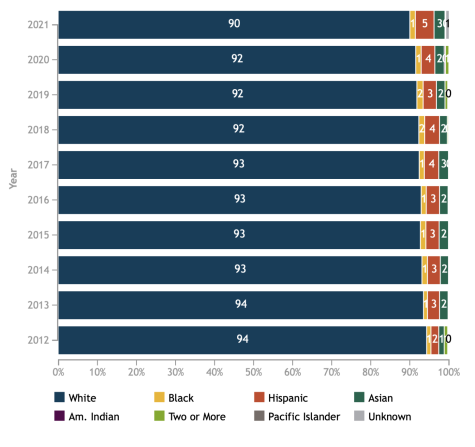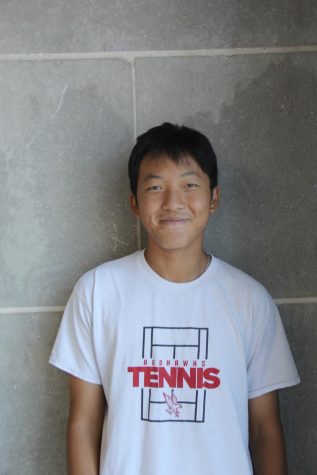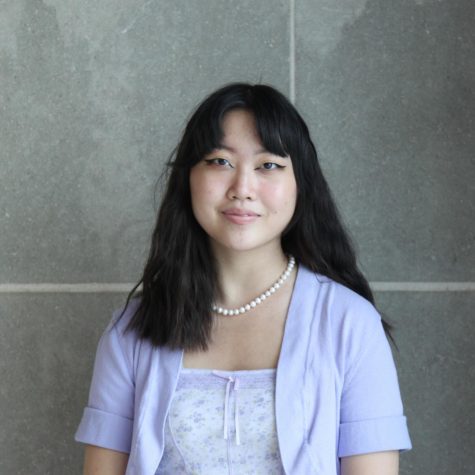Minority teachers at Central reflect on lack of staff diversity
March 7, 2022
Miguel Silva entered the social studies conference rooms at Naperville Central in early May 2017. For the next hour, several teachers — and later, principal Bill Wiesbrook — asked about history and political science content and Silva’s vision for the future of his classroom.
“I remember that day very well,” he said. “That interview was the hardest interview I had.”
The “difficulty of that interview,” he says, came with understanding where he was interviewing. Silva became a social studies teacher at Central the next year.
Silva was one of the 4% of Hispanic teachers hired by District 203 in 2017. While the district has become more diverse in recent years, it still trails behind the Illinois state average.

“Over the last several years, we’ve been developing a recruitment plan to help us increase the number of people of color who apply for jobs here,” said Shelly Nelson, director of human resources & Career 203 for the district.
These efforts include going to historically Black colleges and universities (HBCUs), inviting people of color to serve as guest recruiters and adopting culturally responsible hiring practices. These practices have contributed to the growth in staff diversity.
But, for many minority teachers at Naperville Central, ethnic diversity is still a persisting issue. Brandon Estes, associate director of bands at Central, says he would like to see the staff population become more representative of students.
“You look at all of our classrooms and they’re basically a melting pot,” he said. “A student is going to gravitate more towards the teacher that they can connect with, someone that understands their background.”
Estes is the only certified teacher at Central who is Black. In his experience, whenever there’s conversation about race and equity, it makes for some “uncomfortable conversations when you’re the only one,” he says.
Grace Twietmeyer, a math teacher for 16 years, is Chinese. Diversity, she says, is on her radar.
“I’m one of the few Asian teachers in the building and the district,” she said. “I do think it’s an issue. I feel like if students could look up to teachers who look like them or have similar backgrounds, then it will help them connect more.”
Growing up in an Asian household, Twietmeyer said she had to confront parental expectations, so she finds it easier to empathize with students put under similar expectations.
“Kids would say I can’t get a B,” she says. “But I understand the pressure in an Asian household of how a B to some students is equivalent to an F.”
From a student perspective, diversity in teachers means inclusivity.
“If a person that looked like me had the same culture, religion or language as me, I would obviously be more comfortable with them because there’s a sense of belonging,” freshman Debasnata Dash said. Dash is Indian.
While teachers like Silva, Estes and Twietmeyer don’t have a say in hiring practices, they can make an impact in their classrooms. Across their respective disciplines, each teacher is putting a renewed emphasis on diversity and acceptance in their curriculum.
At the start of any day, Twietmeyer begins with a “fun or [social-emotional learning]” activity. She goes around the classroom asking students for opinions to prompts like would-you-rather questions. Students are allowed to shout out answers.
“So there’s no feeling of ‘oh, I can’t do it because they’re going to check on me,’” she said.
During Lunar New Year, a holiday Twietmeyer celebrates herself, she directed conversation about its cultural significance in hopes of “[opening] up their eyes about it.”
The realm of history is no different. Teaching U.S. history and American government, Silva says that “perspectives and context matter quite a bit” and history can be told through multiple lenses. He makes sure those lenses include diverse perspectives.
To illustrate, he compares his experience on 9/11 as a first grader to that of an older colleague.
“It’s very different, right?” Silva said. “Same historical event with a different perspective. As we go through our nation’s history, it’s important to understand those different perspectives to understand how we get to the [present]. History is a narrative pulled from multiple people.”
The efforts of teachers like Silva, Estes and Twietmeyer and the district administration to promote cultural awareness are not lost on their students.
In November 2021, the Panorama survey of 2,083 students at Naperville Central found that 83% said adults treat students from different races, ethnicities or cultures fairly. About two thirds responded that adults talk about “major news events related to race” often when they occur.
Diversity, however, isn’t limited to race or ethnicity.
“In math, I think it’s important to start with male versus female,” Twietmeyer said. “I want girls to feel like it’s not just a field for boys.”
In the classroom, Twietmeyer is including diverse mathematical works to show her students that “[they] can do it too.”
Senior Jeremy Chou was one of those students; he was in Twietmeyer’s class his freshman year. Chou says having teachers who understand different cultures and are able to communicate that with other staff “might be a good idea.” But, Chou and Dash both agree the district shouldn’t sacrifice teaching experience just for diversity.
For Estes, diversification of staff would help foster connections and representation.
“This is my 11th year here at Naperville Central,” he said. “I’m appreciative of the support that I have from my colleagues, my administrators. But, I think that more attention to diversifying our staffing, when openings are made available, would be highly supportive.”
Walking into that interview room in 2017, Silva knew he provided a special perspective to the staff body at Central.
“I brought a different background., I brought different strengths, different challenges,” he said. “Coming from someone that is Hispanic, someone that grew up right next door in Bolingbrook, and how our experiences may be different even though we’re ten minutes apart.”
Editor’s Note: the E-Newspaper on Feb. 21, 2022 wrote that Twietmeyer is “east-Asian.” To more accurately reflect her ethnicity, it was changed to “Chinese” in the online version.










Jason Verdin • Apr 14, 2022 at 7:59 am
Love this piece. As a first generation American of Mexican parents, I also find myself with different perspectives and experiences than those of my colleagues who are mostly white.
It can be a struggle for non-white teachers to exist in a mostly white space, but slowly things are becoming more diverse.